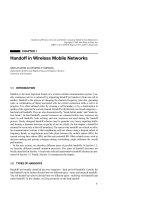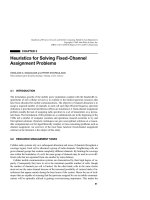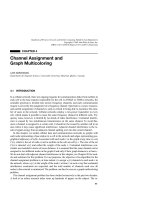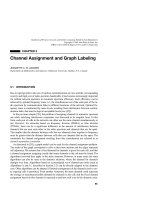Tài liệu Sổ tay của các mạng không dây và điện toán di động P9 pdf
Bạn đang xem bản rút gọn của tài liệu. Xem và tải ngay bản đầy đủ của tài liệu tại đây (158.28 KB, 24 trang )
CHAPTER 9
Randomized Initialization Protocols
for Radio Networks
KOJI NAKANO
Japan Advanced Institute for Science and Technology
STEPHAN OLARIU
Department of Computer Science, Old Dominion University, Norfolk
9.1 INTRODUCTION
In recent years, wireless and mobile communications have seen explosive growth both in
terms of the number of services provided and the types of technologies that have become
available. Indeed, cellular telephony, radio paging, cellular data, and even rudimentary
multimedia services have become commonplace and the demand for enhanced capabili-
ties will continue to grow into the foreseeable future [6, 12, 43, 46]. It is anticipated that in
the not-so-distant future, mobile users will be able to access, while on the move, their data
and other services such as electronic mail, video telephony, stock market news, map ser-
vices, and electronic banking, among many others [12, 21, 41].
A radio network (RN, for short) is a distributed system with no central arbiter, consist-
ing of n radio transceivers, henceforth referred to as stations. We assume that the stations
are bulk-produced hand-held devices running on batteries and that it is impossible or im-
practical to distinguish them by serial or manufacturing numbers. Unlike the well-studied
cellular systems that assume the existence of a robust infrastructure, the RNs are self-or-
ganizing, rapidly deployable, possibly multihop, and do not rely on an existing infrastruc-
ture. These networks find applications in disaster relief, interactive mission planning,
search-and-rescue, law enforcement, multimedia classroom, and collaborative computing,
among other special-purpose applications [16, 18, 20, 23, 26, 28]. At the system level,
scalability and topology management concerns suggest a hierarchical organization of RN
systems [20, 23, 26, 36, 41, 43], with the lowest level in the hierarchy being a cluster, typ-
ically a single-hop subsystem. As argued in [20, 23, 26, 36, 40, 41, 43], in addition to
helping with scalability and robustness, aggregating stations into clusters and, further, into
superclusters has the added benefit of concealing the details of global network topology
from individual stations.
An important task to perform is that of assigning the n stations of the radio network
distinct ID numbers (vaguely similar to IP addresses) in the range 1 to n. This task is
known as initialization and, we argue, is fundamental, as many of the existing protocols
195
Handbook of Wireless Networks and Mobile Computing, Edited by Ivan Stojmenovic´
Copyright © 2002 John Wiley & Sons, Inc.
ISBNs: 0-471-41902-8 (Paper); 0-471-22456-1 (Electronic)
for radio networks tacitly assume that the stations already have IDs. The initialization
problem is nontrivial since the stations are assumed to be indistinguishable. Further, since
the stations are power-limited, it is of importance to design energy-efficient initialization
protocols for single-hop RNs both in the case where the system has a collision detection
capability and in the case where this capability is not present.
As customary, time is assumed to be slotted and all the stations have a local clock that
keeps synchronous time by interfacing with a global positioning system (GPS, for short)
[15, 24]. We note here that under current technology, the commercially available GPS sys-
tem (GPS systems using military codes achieve an accuracy that is orders of magnitude
better than commercial codes) provides location information accurate within 22 meters as
well as time information accurate to within 100 nanoseconds [15]. This is more than suffi-
cient for the stations to synchronize. The stations are assumed to have the computing pow-
er of a laptop computer; in particular, they all run the same protocol and can generate ran-
dom bits that provide local data on which the stations may perform computations.
The stations communicate using k, (k Ն 1), radio frequencies channels. We assume that
in a time slot, a station can tune to one radio channel and/or transmit on at most one (pos-
sibly the same) channel. A transmission involves a data packet whose length is such that
the transmission can be completed within one time slot. We employ the commonly accept-
ed assumption that when two or more stations are transmitting on a channel in the same
time slot, the corresponding packets collide and are garbled beyond recognition. We dis-
tinguish between RN systems based on their capability to detect collisions. Specifically, in
the RN with collision detection (CD, for short), at the end of a time slot the status of a ra-
dio channel is:
ț NULL—no transmission on the channel
ț SINGLE—exactly one transmission on the channel
ț COLLISION—two or more transmissions on the channel
In the RN with no collision detection (no-CD, for short), at the end of a time slot the status
of a radio channel is:
ț NOISE—ambient noise: either no transmission or collision of several transmissions
on the channel
ț SINGLE—exactly one transmission on the channel
In other words, the RN with no-CD cannot distinguish between ambient noise and two or
more transmissions colliding on the channel. A number of radio and cellular networks in-
cluding AMPS, GSM, ALOHA-net, as well as the well-known Ethernet are known to rely
on sophisticated collision detection capabilities [1, 2, 10, 11, 12, 29]. However, several
workers have pointed out that from a practical standpoint the no-CD assumption makes a
lot of sense, especially in the presence of noisy channels, which, we argue, tends to be the
norm rather than the exception. Given the additional limitations, it is far more challenging
to design efficient protocols for RNs with no-CD than for those with collision detection
capabilities [8, 9].
It is very important to realize that since the stations of the RN are running on batteries,
196
RANDOMIZED INITIALIZATION PROTOCOLS FOR RADIO NETWORKS
saving battery power is exceedingly important, as recharging batteries may not be an op-
tion while on mission. It is well known that a station expends power while its transceiver is
active, that is, while transmitting or receiving a packet. It is perhaps surprising at first that
a station expends power even if it receives a packet that is not destined for it [7, 19, 21, 39,
42, 44, 45]. Consequently, we are interested in developing protocols that allow stations to
power their transceiver off (i.e., “go to sleep”) to the largest extent possible. Accordingly,
we judge the goodness of a protocol by the following two yardsticks:
1. The overall number of time slots required by the protocol to terminate
2. For each individual station, the total number of time slots in which it has to be
awake in order to transmit/receive packets
The individual goals of optimizing these parameters are, of course, conflicting. It is rela-
tively straightforward to minimize overall completion time at the expense of energy con-
sumption. Similarly, one can minimize energy consumption at the expense of completion
time [44, 45, 46]. The challenge is to strike a sensible balance between the two by design-
ing protocols that take a small number of time slots to terminate while being, at the same
time, as energy-efficient as possible.
The main goal of this chapter is to survey some of the recent initialization protocols for
single-hop RN. The remainder of this chapter is organized as follows. Section 9.2 surveys
the state of the art. Section 9.3 reviews basic probability theory necessary to analyze the
initialization protocols. Section 9.4 discusses a number of energy-efficient prefix sum
protocols that will turn out to be key ingredients in the remainder of this chapter. In Sec-
tion 9.5 we present known initialization protocols for single-channel radio networks. Sec-
tion 9.6 provides an extension of the single-channel initialization protocols to the case
where k channels are available. Section 9.7 presents a number of energy-efficient initial-
ization protocols for k channel RNs. Finally, Section 9.8 offers concluding remarks and
open problems.
9.2 STATE OF THE ART
As stated previously, the initialization problem involves assigning each of the n stations of
an RN an integer ID number in the range 1 to n such that no two stations share the same
ID.
The initialization problem is fundamental in both network design and in multiprocessor
systems [32, 37]. Recent advances in wireless communications and mobile computing
have exacerbated the need for efficient protocols for RNs. As a result, a large number of
such protocols have been reported in the literature [3, 17, 32, 33]. However, virtually all
these protocols function under the assumption that the n stations in the RN have been ini-
tialized in advance. The highly nontrivial task of assigning the stations distinct ID num-
bers, i.e., initializing the stations, is often ignored in the literature. It is, therefore, of im-
portance to design energy-efficient initialization protocols for RNs both in the case where
the system has a collision detection capability and for the case where this capability is not
present.
9.2 STATE OF THE ART
197
In the broad area of distributed computing, the initialization problem is also known as
the processor identity or the processor naming problem. The processor identity problem
and its variants, including renaming processors, has been addressed in the literature. We
refer the interested reader to [4, 5, 14, 25, 27, 38] and to the various other references there-
in.
In the context of radio networks, Hayashi et al. [22] presented a protocol that initializes
a single-channel, n-station RN with CD in O(n) time slots with probability at least 1 –
1/2
O(n)
. The protocol repeatedly partitions the stations of the RN into nonempty subsets
until, eventually, every subset consists of a single station. Further, Nakano and Olariu [34]
have presented an initialization protocol for k channel, n station RNs with CD terminating,
with probability exceeding 1 – 1/n, in 10n/3k + O(͙(n
ෆ
l
ෆ
n
ෆ
n
ෆ
)/
ෆ
k
ෆ
) time slots. They also
showed that if the collision detection capability is not present, the RN can be initialized,
with high probability, in 5.67n/k + O
(
͙(n
ෆ
l
ෆ
n
ෆ
n
ෆ
)/
ෆ
k
ෆ
)
time slots. More recently, Mici ´c and
Stojmenovi ´c [30] improved the constant factor of the time slots necessary to initialize a
single-channel, n station RN with CD.
Bordim et al. [13] showed that, if the number n of stations is known beforehand, a
single-channel n station RN with CD can be initialized, with probability exceeding 1 –
1/n, in O(n) time slots with no station being awake for more than O(log n) time slots.
This protocol uses the initialization protocol of [22] as follows: having partitioned the n
stations into n/log n subsets of roughly log n stations, each subset is initialized individ-
ually. The key observation is that a station needs to be awake only for the time necessary
to initialize the subset to which it belongs. By using the protocol of [22], each subset can
be initialized, with probability exceeding 1 – 1/2
O(log n)
, in O(log n) time slots and, thus,
no station has to be awake for more than O(log n) time slots. Once each subset has been
initialized, a simple prefix sum computation allows the stations to update their local ID
to the desired ID. Bordim et al. [13] went on to show how to use the single-channel ini-
tialization protocol to initialize, with probability exceeding 1 – 1/n, a k channel, (k Յ
n/log n), RN with CD in O(n/k) time slots with no station being awake for more than
O(log n) time slots. More recently, Nakano and Olariu [35] presented an initialization
protocol for k channel, n station RNs with no-CD terminating, with probability exceed-
ing 1 – 1/n, in O(n/k + log n) time slots, with no station being awake for more than
O(log log n) time slots.
9.3 A REFRESHER OF BASIC PROBABILITY THEORY
The main goal of this section is to review elementary probability theory results that are
useful for analyzing the performance of our protocols. For a more detailed discussion of
background material we refer the reader to [31].
Throughout, Pr[A] will denote the probability of event A. Let E
1
, E
2
, ..., E
m
be arbi-
trary events over a sample space. The well-known De Morgan law states that
____
m
ʝ
i=1
E
i
=
m
ʜ
i=1
E
ෆ
i
ෆ
(9.1)
198
RANDOMIZED INITIALIZATION PROTOCOLS FOR RADIO NETWORKS
where E
ෆ
i
ෆ
is the event that occurs if and only if E
i
does not. In addition, it is known that
Pr
΄
m
ʜ
i=1
EE
i
΅
Յ
Α
m
i=1
Pr[E
i
] (9.2)
with equality holding if the events E
i
s are disjoint.
For example, assume that the stations of an RN have been partitioned into k groups G
1
,
G
2
, ..., G
k
and that for a given i, (1 Յ i
Յ
k), the probability of the event E
ෆ
i
ෆ
that group G
i
fails to satisfy a predicate P is p
i
. Now, (9.1) and (9.2) combined guarantee that the proba-
bility of the event that all the groups satisfy predicate P is:
Pr[E
1
ʝ E
2
ʝ ··· ʝ E
k
] = 1 – Pr[E
ෆ
1
ෆ
ෆ
ʝ
ෆ
ෆ
E
ෆ
2
ෆ
ෆ
ʝ
ෆ
ෆ
·
ෆෆ
·
ෆෆ
·
ෆෆ
ʝ
ෆ
ෆ
E
ෆ
k
ෆ
]
= 1 – Pr[E
ෆ
1
ෆ
ʜ E
ෆ
2
ෆ
ʜ ··· ʜ E
ෆ
k
ෆ
] Ն 1 –
Α
m
i=1
p
i
(9.3)
Notice that (3) holds regardless of whether or not the events E
ෆ
i
ෆ
are independent.
For a random variable X, E[X] denotes the expected value of X. Let X be a random vari-
able denoting the number of successes in n independent Bernoulli trials with parameters p
and 1 – p. It is well known that X has a binomial distribution and that for every r, (0 Յ r
Յ
n),
Pr[X = r] =
p
r
(1 – p)
n–r
(9.4)
Further, the expected value of X is given by
E[X] =
Α
n
r=0
r · Pr[X = r] = np (9.5)
To analyze the tail of the binomial distribution, we shall make use of the following esti-
mate, commonly referred to as Chernoff bound [31]:
Pr{X > (1 +
␦
)E[X]}
<
E[X]
(0 Յ
␦
) (9.6)
We will also rely on the following estimates that can be derived from (9.6):
Pr{X Յ (1 –
⑀
)E[X]} Յ e
–(
⑀
2
/2)E[X]
(0 Յ
⑀
Յ 1) (9.7)
Pr{X Ն (1 +
⑀
)E[X]} Յ e
–(
⑀
2
/3)E[X]
(0 Յ
⑀
Յ 1) (9.8)
Let X be the random variable denoting the number of successes in a number
␣
(n) of in-
dependent Bernoulli trials, each succeeding with probability p. Clearly, E[X] = p ·
␣
(n).
e
␦
ᎏᎏ
(1 +
␦
)
(1+
␦
)
n
r
9.3 A REFRESHER OF BASIC PROBABILITY THEORY
199
Our goal is to determine the values of E[X] and
␣
(n) in such a way that, for any fixed f Ն
1, equation (9.7) yields:
Pr[X < n] = Pr{X < (1 –
⑀
)E[X]} < e
–(
⑀
2
/2)E[X]
= (9.9)
It is easy to verify that (9.9) holds whenever*
Ά
(9.10)
hold true. From (9.10), we have
(E[X])
2
– 2(n + ln f )E[X] + n
2
= 0 (9.11)
Solving for E[X] in (9.11) we obtain:
E[X] = n + ln f + ͙2
ෆ
n
ෆ
l
ෆ
n
ෆ
f
ෆ
+
ෆ
(
ෆ
ln
ෆ
f
ෆ
)
2
ෆ
< n + 2ln f + o(n + ln f ) (9.12)
Equation (9.12) allows the desired determination of
␣
(n). That is,
␣
(n) = pE[X] < pn + 2p ln f + o[p(n + ln f )] (9.13)
We note here that (9.13) will be used repeatedly in the remainder of this chapter to bound
the tail of various binomial distributions.
Finally, we take note of following classic double inequality that will be used frequently
in the remainder of this work.
Lemma 3.1 For every natural number n, (n Ն 2), (1 – 1/n)
n
< 1/e < 1 – (1/n)
n–1
.
9.4 ENERGY-EFFICIENT PREFIX SUMS PROTOCOLS
The purpose of this section is to discuss energy-efficient prefix sums protocols for single-
hop radio stations.
Consider first the case of a single-hop, single-channel RN with n (n Յ m) stations each
of which have a unique ID in the range [1, m]. Let S
i
(1 Յ i
Յ
m) denote the station with
ID i. Note that for some i, S
i
may not exist.
We assume that every station S
i
stores a number x
i
. The well-known prefix sums prob-
lem seeks to determine for every S
i
the sum of x
j
s with indices no larger than i, that is,
Α
{x
j
| 1 Յ j
Յ
i and S
j
exists}
(1 –
⑀
)E[X] = n
(
⑀
2
/2)E[X] = ln f
1
ᎏ
f
200
RANDOMIZED INITIALIZATION PROTOCOLS FOR RADIO NETWORKS
*In this work we let ln n and log n denote the natural logarithm and the logarithm to base 2, respectively.
A naive protocol to solve the prefix sums problem in m – 1 time slots proceeds as follows:
in time slot j, (1 Յ j
Յ
m – 1), station S
j
transmits x
j
on the channel, and every station S
i
( j < i) monitors the channel. By summing the numbers transmitted, each station can deter-
mine the corresponding prefix sum. Observe that this simple protocol is not energy effi-
cient, because the last station S
m
has to be awake for m – 1 time slots.
We now introduce an energy-efficient protocol to solve the prefix sums problem. When
our protocol terminates, the following three conditions are satisfied:
1. Every active station S
i
, (1 Յ i
Յ
n), stores its prefix sum.
2. The last station S
k
, such that no station S
i
with i > k exists, has been identified.
3. The protocol takes 2m – 2 time slots and no station is awake for more than 2 log m
time slots.
If m = 1, then S
1
knows x
1
and the above conditions are verified. Now, assume that m Ն
2 and partition the n stations into two groups P
1
= {S
i
| 1 Յ i
Յ
m/2} and P
2
= {S
i
| m/2 + 1
Յ i
Յ
m}. Recursively solve the prefix sums problem in P
1
and P
2
. By the induction hy-
pothesis, conditions (1)–(3) above are satisfied and, therefore, each of the two subprob-
lems can be solved in m – 2 time slots, with no station being awake for more than 2 log m
– 2 time slots.
Let S
j
and S
k
be the last active stations in P
1
and in P
2
, respectively. In the next time
slot, station S
j
transmits the sum ⌺{x
i
| 1 Յ i
Յ
j and S
i
ʦ P
1
exists} on the channel. Every
station in P
2
monitors the channel and updates accordingly the value of its prefix sum. In
one additional time slot, station S
k
reveals its identity.
The reader should have no difficulty confirming that when the protocol terminates,
conditions (1)–(3) above are satisfied. To summarize, we have proved the following result.
Lemma 4.1 Assuming that the n (n
Յ
m) stations of a single-hop, single-channel, radio
network have unique IDs in the range [1, m], the prefix sums problem can be solved in 2m
– 2 time slots, with no station being awake for more than 2log m time slots.
We next extend the energy-efficient prefix sums protocol for single-channel RNs to the
case where k (k Ն 1) channels are available. We begin by partitioning the stations into k
equal-sized groups G
1
, G
2
, ..., G
k
such that G
i
= {S
j
| (i – 1) · m/k + 1 Յ j
Յ
i · m/k and S
j
exists}. By assigning one channel to each such group, the instance of the prefix sums
problem local to each group G
i
can be solved using the protocol for the single-channel
case discussed above. By Lemma 4.1, this task can be completed in 2m/k – 2 time slots,
with no station being awake for more than 2 log m/k time slots.
At this point, we have the local sum sum(G
i
) of each G
i
and we need to compute the
prefix sums of sum(G
1
), sum(G
2
), ..., sum(G
k
). This can be done by modifying slightly
the protocol described for the single-channel RN. Recall that in the single-channel proto-
col, the prefix sums of P
1
are computed recursively, and those for P
2
are computed recur-
sively. Since k channels are available, the prefix sums of P
1
and P
2
are computed simulta-
neously by allocating k/2 channels to each of them. After that, the overall solution can be
obtained in two more time slots. Using this idea, the prefix sums problem can be solved in
9.4 ENERGY-EFFICIENT PREFIX SUMS PROTOCOLS
201
2m/k + 2 log k – 2 time slots, with no station being awake for more than 2 log m/k + 2 log
k = 2 log m time slots. To summarize, we have proved the following result.
Lemma 4.2 Assuming that the n (n Յ m) stations of a single-hop, k channel radio net-
work have unique IDs in the range [1, m], the prefix sums problem can be solved in 2m/k
+ 2 log k – 2 time slots, with no station being awake for more than 2 log m time slots.
The next result specializes Lemma 4.2 to the case of a single-hop, k channel radio net-
work with at most k stations with distinct IDs in the range [1, k].
Corollary 4.3 Assuming that the k stations of a single-hop, k channel radio network
have unique IDs in the range [1, k], the prefix sums problem can be solved in 2 log k time
slots.
9.5 INITIALIZING A SINGLE-CHANNEL RN
This section presents initialization protocols for single-hop, single-channel, n station radio
networks. In Subsection 9.5.1, we focus on the task of initializing a radio network with no
collision detection capabilities, where the number n of stations is known in advance. This
first protocol terminates, with probability exceeding 1 – 1/f , in en + 2e ln f + o(n + ln f )
time slots. In Subsections 9.5.2 and 9.5.3, we turn to the more realistic case where the
number n of stations is not known in advance. Specifically, in Subsection 9.5.2 we show
that if the collision detection capability is present, an n station radio network can be ini-
tialized by a protocol terminating, with probability exceeding 1 – 1/f , in 4n + 8 ln f + o(n
+ ln f ) time slots. Finally, in Subsection 9.5.3 we show that if the stations lack collision de-
tection, initialization can be performed, with probability exceeding 1 – 1/f , in 12n +
O[(log f )
2
] + o(n) time slots.
9.5.1 Protocol for Known n and No CD
Consider a single-hop, single-channel n station RN where the number n of stations is
known in advance. The idea of the initialization protocol is quite simple and intuitive. To
begin, each station transmits on the channel with probability 1/n until the status of the
channel is single. At this point, the station that has transmitted receives the ID of 1 and
leaves the protocol. Next, the remaining stations transmit on the channel with probability
1/n – 1 until the status of the channel is single. Again, the unique station that has transmit-
ted in the last time slot receives the ID of 2 and leaves the protocol. This is then continued
until all the stations have received their IDs. The details are spelled out as follows.
Protocol Initialization-for-known-n
for m
ǟ
n downto 1 do
repeat
each station transmits on the channel with probability 1/m (ଙ)
until the status of the channel is SINGLE;
202
RANDOMIZED INITIALIZATION PROTOCOLS FOR RADIO NETWORKS
the unique station that has transmitted in the previous time slot
receives ID number n – m + 1 and leaves the protocol
endfor
The correctness of protocol Initialization-for-known-n being easily seen,
we now turn to the task of evaluating the number of time slots it takes the protocol to ter-
minate. We say that the current time slot in step (ଙ) is successful if the status of the chan-
nel is single. Let X be the random variable denoting the number of stations transmitting in
a given time slot. Then, by virtue of (9.4) and of Lemma 3.1, at the end of this time slot the
status of the channel is single with probability
Pr[X = 1] =
1
1 –
m–1
=
1 –
m–1
> (by Lemma 3.1)
Clearly, protocol Initialization-for-known-n requires n successful time slots
to terminate. Let Y be the random variable denoting the number of successful time slots
among the first
␣
(n) time slots in step (ଙ) of the protocol. It is clear that E[Y] >
␣
(n)/e.
We wish to determine
␣
(n) such that for every f Ն 1
Pr[Y < n] = Pr{Y < (1 –
⑀
)E[Y]} <
Now, using (9.13) we obtain E[Y] = n + 2 ln f + o(n + ln f ) and, therefore,
␣
(n) = en + 2e ln
f + o(n + ln f ).
We just proved that with probability exceeding 1 – 1/f , among the first en + 2e ln f +
o(n + ln f ) time slots there are at least n successful ones.
Importantly, our protocol does not rely on the existence of the collision detection capa-
bility. Therefore, we have the following result.
Theorem 5.1 The task of initializing a single-hop, single-channel n station radio net-
work with known n terminates, with probability exceeding 1 – 1/f ( f Ն 1), in en + 2e ln f
+ o(n + ln f ) time slots, regardless of whether or not the system has collision detection ca-
pabilities.
9.5.2 Protocol for Unknown n: The CD Case
The idea behind the initialization protocol for the single-channel RN with CD is to con-
struct a full binary tree (each of whose internal nodes has exactly two children) that we
call a partition tree. As it turns out, the leaves of the partition tree are, with high probabil-
ity, individual stations of the RN. Some leaves may be empty but, as we shall see, this
event has a small probability. The internal nodes of the partition tree are associated with
groups of two or more stations. By flipping coins, these stations will be assigned to the
1
ᎏ
f
1
ᎏ
e
1
ᎏ
m
1
ᎏ
m
1
ᎏ
m
m
1
9.5 INITIALIZING A SINGLE-CHANNEL RN
203









